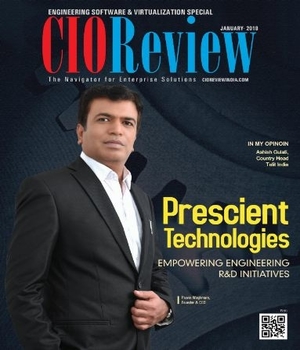
4 Steps to Lean in Industry 4.0
Joe Panebianco, Director of Manufacturing Engineering, Tekni-Plex, Inc. | Wednesday, 27 December 2017, 09:33 IST
 Lean is about the elimination of waste. Often lean practitioners look at a process or activity to see how waste might be removed, lead-time reduced and flow created. While the objective is to eliminate waste and create flow through the entire value stream from material procurement to receipt of customer payment, most of the time, waste elimination is considered only in a single process/function or occasionally in adjacent areas. Seldom do people consider how removal of waste affects the entire value chain because of a change in one specific area. Even if a more holistic approach is considered, it is often within a functional area.
Lean is about the elimination of waste. Often lean practitioners look at a process or activity to see how waste might be removed, lead-time reduced and flow created. While the objective is to eliminate waste and create flow through the entire value stream from material procurement to receipt of customer payment, most of the time, waste elimination is considered only in a single process/function or occasionally in adjacent areas. Seldom do people consider how removal of waste affects the entire value chain because of a change in one specific area. Even if a more holistic approach is considered, it is often within a functional area.
For example, a company might achieve a better per unit price if they purchase a greater quantity at one time. The supply chain team would look at various pricing options and consider cash flow, amount to purchase and inventory carrying cost. They would then determine if the optimal solution (least wasteful) is to buy larger quantities at a lower per unit price but incur other costs from working capital and warehousing, or continue to buy at lower quantities yet pay higher prices. In this example, the optimal solution is within the control of the supply chain. What happens if different functional areas or areas of domain knowledge are required to determine the optimal solution?
Consider another situation: A company has the ability to reduce material scrap by ordering raw material in a larger number of sizes that are closer to the finished product size. However, ordering more sizes will increase other costs, such as equipment changeover cost and inventory carrying cost. Does it make more sense to order 30 different raw material sizes and minimize the scrap material cost, or order 15 different raw materials and have a higher material scrap but lower inventory-carrying cost? This example impacts supply chain and operation costs. Not only do supply chain and operations fall under different leadership in many companies, but the individuals in these areas may not have all of the expertise and knowledge to fully evaluate this problem. Yet an optimal solution to this problem must be modelled and found. Is the least wasteful solution to have 8, 10 or 12 different raw materials, and which ones of the 30 should be selected? How much will operating costs increase and how much will supply chain costs decrease?
Recently, the Internet of Things (IoT) and Industry 4.0 has received much press, but I find most of these examples are still limited to improvement in one area or adjacent areas. Even with the examples of adjacent improvement, the benefits are mutual—meaning, if one area is improved another will also consequently improve. For example, if you use 3D design and modelling with rapid prototyping of a product to reduce design cost and time, the startup and production costs are lower. The IoT and Industry 4.0 will provide us with more data and opportunities to solve problems like the one in the material scrap reduction above, but in order to do this it will require four things:
1. A Systems Thinking Approach. Systems thinking is the discipline that defines the linkages and interaction between components within a system. To find these types of opportunities for improvement requires taking a macro-level view and working to understand complex interactions that may not have been identified previously.
2. Shift in Leadership Philosophy. Leadership needs to understand and support these interactions and changes in the system, despite the fact that their personal performance and objectives may be impacted. In the earlier discussion of ordering varying sizes of raw material, the optimal solution could involve increasing material scrap, which would make the manufacturing team look worse, but the supply chain costs could be reduced significantly as a result of this change. The best solution for the business must be chosen, but if egos and objectives interfere or management compensation does not encourage this type of decision-making, a systems thinking approach becomes difficult to implement.
3. Access to Good Data. Access to reliable, solid data and appropriate metrics is required for evaluation of these types of systems problems. Data must be reported in a way that numbers help to make natural connections between raw material and finished goods. Create and link data from procurement to payment order to cash, and even information from how the product performs when used by the customer. Develop systems that allow for easy retrieval and download, and allow users to explore the data.
4. Highly Trained Staff and Tools. Analytical tools and the people that can run these calculations are required. You need to be able to perform analyses such as forecast sales with regression; use optimization to select equipment, material and inventory levels; and use risk analysis for capital investment and inventory stock out. Wall Street has made a fortune with good analytics—why shouldn’t manufacturing?
For as much as things change in industry, my thoughts still go back to the basic lean principal of the need to eliminate waste. However, it is up to us to take this to the next level—adapting practices across the entire organization and realizing that analytics can help us capitalize on previously unrecognized opportunities for improvement.
CIO Viewpoint
Digital Transformation In Manufacturing
By Jacob Peter, Head IT, Bosch Engineering and Business Solutions
When Technology Meets the World of Financial...
By Vamsi Krishna Ithamraju, Group IT Head, CreditAccess Asia
By Daljit Singh Sodhi, Associate Director-IT at KPMG India
CXO Insights
4 Steps to Lean in Industry 4.0
By Joe Panebianco, Director of Manufacturing Engineering, Tekni-Plex, Inc.
Standing at the Crossroad of Lean Manufacturing...






